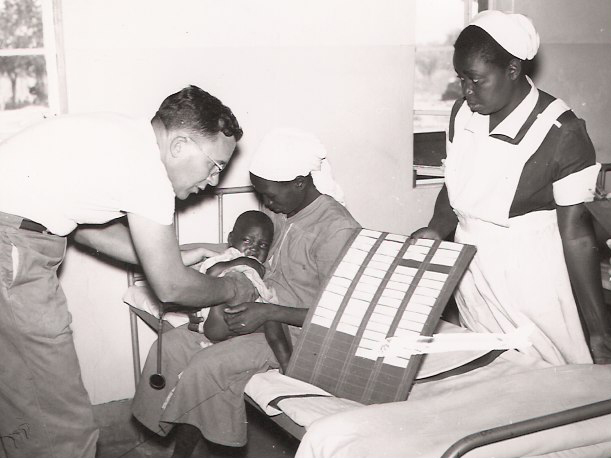
In 1950, Dr. Alvan Thuma became the first medical missionary to serve under the auspices of Brethren in Christ World Missions, volunteering to staff the small hospital under construction at the Mtshabezi Mission in Southern Rhodesia (present-day Zimbabwe). As Carlton Wittlinger reported in his history of the Brethren in Christ Church, one long-time missionary called Thuma’s arrival “a great day for the African work.” [1]
A few years later, in 1954, Thuma traveled to the Macha Mission in Northern Rhodesia (present-day Zambia) to pioneer a new hospital work. As Wittlinger writes,
The missionaries used both education and medical work as a means to evangelize and extend their Christian witness. They always, however, stressed direct evangelism and church extension through preaching and village visitation. [2]
A 1953 report, written by Dr. Thuma for the Evangelical Visitor just before he moved to Macha, illustrates the way his medical work overlapped with his evangelistic mission.
Most of the experiences of a missionary on the field come under the heading of “Struggle for Survival — Both Physically and Spiritually.” Sometimes the struggle is for yourself but most times it is for the people you have been called to serve. For a medical missionary, sometimes this struggle takes on a little different aspect than it does for other missionaries.
The best way to illustrate this would be by telling the story of Naka Ina (Mother of Ina) who came to the hospital over a year ago.
Her case history would be summed up thusly: married native female, age about 25, mother to two children, weight 95 pounds, complaining of tiredness, weight loss, coughing, and being hot. These symptoms had become worse over the past three months.
. . . Sputum examination showed that she had tuberculosis and the cavernous breath sounds left no doubt in your mind that with cavities in her lungs, she was “not long for this world.”
Treatment: With far advanced tuberculosis, it was hopeless to try to treat her physically but we realized that her spiritual condition was even more hopeless unless it received special attention. After we told her plainly what her condition was, we talked to her often and prayed with her and she seemed to realize her need of a Savior and accepted Him.
She wanted to go home to die, which request was granted. . . . I decided to take her in the ambulance on a Saturday afternoon. . . . And I asked Bert [Winger] to go along to the village which was near the Mtshabezi River. . . . Bert took the opportunity to hold a little service for everyone’s benefit but mainly for Naka Ina’s. It was short and to the point: that one must follow closely the teachings of Christ after one accepts Him as their Savior.
About three months later, I was called late one afternoon and told that she was about to die and had given birth to her child. They did not ask me to come to help her physically but only stated she would like to talk to me.
At the village, the usual group of old women were in the hut with her and I found they had done well in their midwifery. Naka Ina was very weak and coughing much from the congestion in her lungs. . . . Kneeling there in the hut . . . I spoke from John 3:15-17 and gave, I believe, one of the greatest messages I will ever preach. At the close, Naka Ina said she was happy, no longer distracted in her soul and ready to die. Several days later, she died and was buried near the village cattle kraal. No one preached her funeral; I had done that two days earlier. [3]
For more information on Alvan Thuma, see E. Morris Sider, ed., My Story, My Song: Life Stories by Brethren in Christ Missionaries (Mt. Joy, Pa.: Brethren in Christ World Missions, 1989), 496-505.
Notes:
[1] Quest for Piety and Obedience (Nappanee, Ind.: Evangel Press, 1978), 459.
